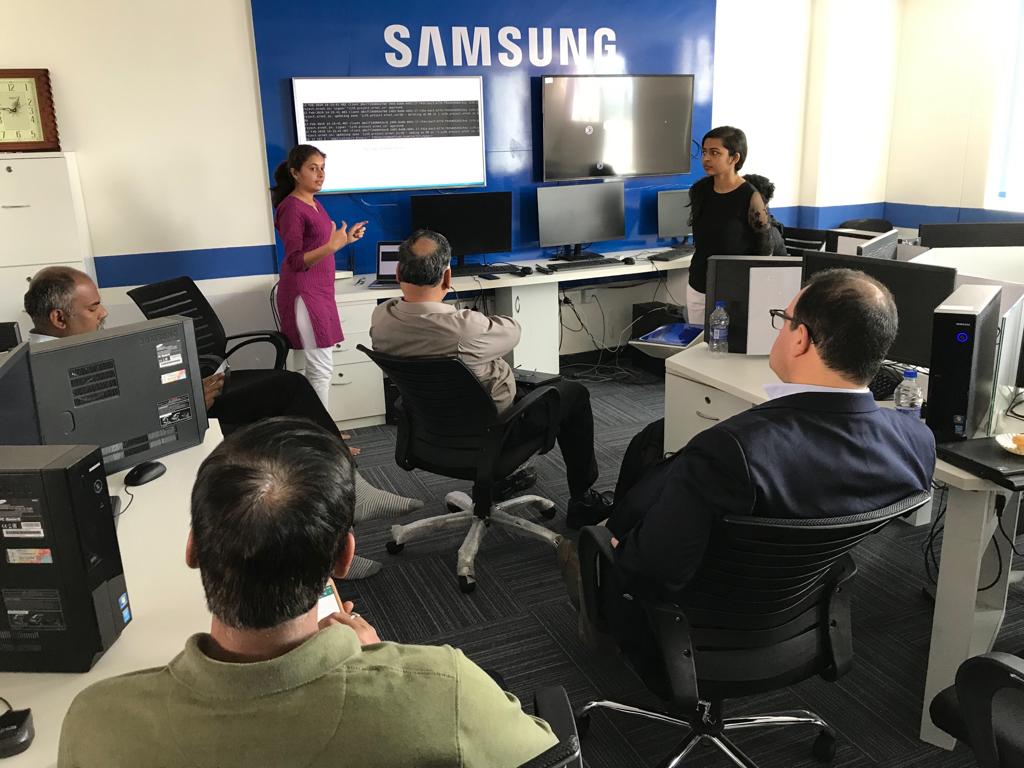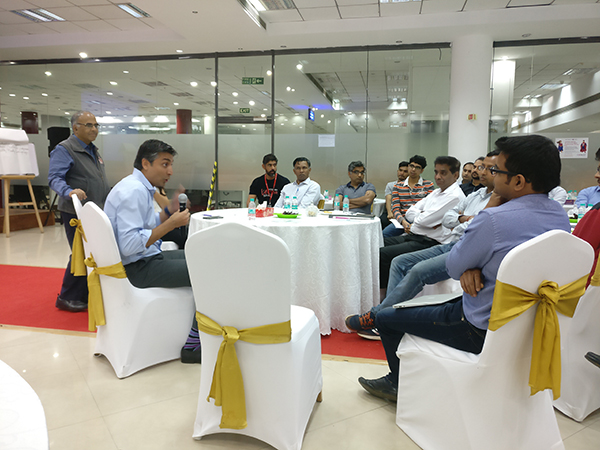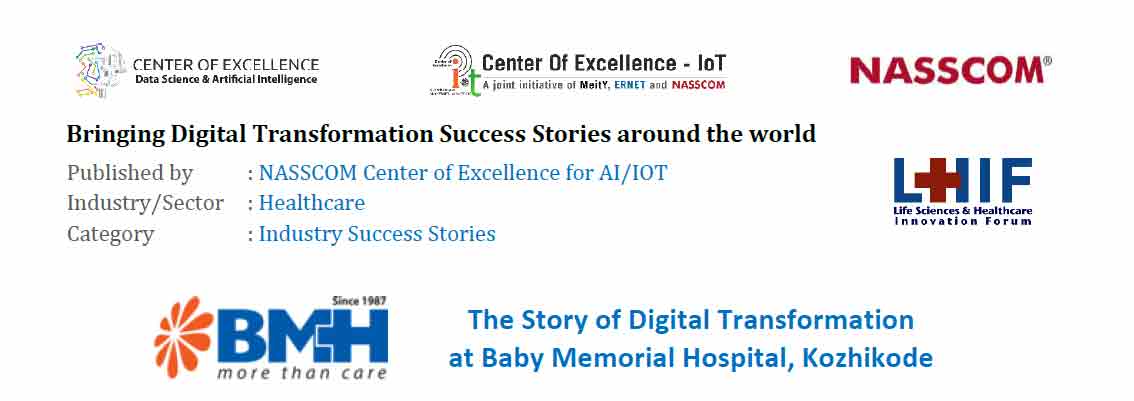Alain Durand, principal technologist of Internet Corporation for Assigned Names & Numbers (ICANN) paid a visit to the NASSCOM Center of Excellence Gurugram, where there was a vibrant and informative exchange on the potential benefits of establishing standards to the current proprietary systems of firmware download for IOT devices, and the benefits of adopting IPv6 over IPv4.
Author: coeblog
ICANN Principal Technologist Alain Durand discusses scope of research on Draft Durand Object Exchange
Durand talks about challenges and benefits of IPv6 adoption at NASSCOM CoE

India is a thriving hub for AI; Skilled talent key to its growth
The digital progression of every company today is heavily reliant on technology, and Artificial Intelligence (AI) is the current wave that enterprises are riding on. Companies world over have recognized that AI is changing the way business is being done and the very nature of every business enterprise is becoming “DIGITAL FIRST”, making AI crucial not only to their growth but in some cases to their metamorphosis as a digital enterprise, and subsequently, their survival. This is driving them to adopt, adapt and strengthen their AI applicability and fortify their businesses. This inevitably means ensuring AI competence is built and updated continuously.
Japanese delegation visits CoE’s Innovation Lab in Bangalore
NASSCOM hosted a Japanese delegation in Bangalore on 5th February to discuss collaborative efforts between Japan and India to boost the startup ecosystem.
Kenji Hiramatsu, ambassador extraordinary and plenipotentiary, Embassy of Japan; Tetsuya Uetake, first secretary, Food & Agriculture, Embassy of Japan; and Takayuki Kitagawa, consul general, Consulate General of Japan interacted with NASSCOM’s senior leaders including KS Viswanathan, vice-president, Industry Initiatives, Sanjeev Malhotra, CEO of Center of Excellence and Gagan Sabharwal, senior director for Global Trade Development over digital integration for corporates, supporting the technology and startup ecosystem.


NASSCOM Chairman Rishad Premji interacts with startups in Bangalore
LHIF 4 workshop in Mumbai on 20th December
“Re-Calibrating the Care-Continuum with Technology Innovation”
Event Report
85+ Select Audience | 40+ Start-ups | First Time in Mumbai
Pronounced as LIFE, the Lifesciences and Healthcare Innovation Forum (LHIF) is an initiative by NASSCOM Center of Excellence for AI/IoT to provide a collaborative platform for the healthcare delivery eco-system to explore and adopt innovation in their organizations. The 4th edition of the LHIF was hosted in Mumbai on 20th Dec 2018.
Introductory note on the Collaborative initiatives by NASSCOM Center of Excellence for AI/IoT
Mr. Raghuram Janapareddy
Director- Open Innovation
NASSCOM Center of Excellence
The conclave was very innovative and inclusive. The introductory session set the context and shared insights about the key players of the Lifesciences and Healthcare industry involving medical device companies, pharma, government, and the start-ups. The main agenda of the workshop was to catalyze the transformation of the Lifesciences and the Healthcare Industry leveraging the innovative ecosystem. With the millennium development goals posing a challenge on the healthcare delivery eco-system, it is time to look at various initiatives from the Government and the social impact projects taken up by the private players. We need to take a cue from these initiatives to replicate them at a larger scale. For the first time, the event also recognized the innovative success stories from the startups and the enterprises. The event also created a healthy networking platform for the audience to interact with each other.
Power Key Note: Changing the face of Healthcare Delivery through Technology Driven Initiatives from the Government by Dr.B.K. Murthy
The power key note addressed the IT initiatives by the government of India. The government of India has taken the initiative of digitization of hospitals through Hospital Information System. The objective of this is to optimize the available resources, reduction in patient waiting time and reduction in clinical errors. Government has taken an initiative of deploying this Information system through CDAC’s e-Sushrut and NIC’s e-hospital system, which at present is being used by 400 government hospitals across India. He also addressed the gathering about the standardization of Electronic Health Record for better data exchange. This is initiative focuses on creating central health repository.
Dr. B.K. Murthy
Senior Director, MeitY
Group Coordinator C-DAC
Government of India
The digitization of blood bank is to bring transparency by providing availability of stock position online. e-Raktkosh is one platform to bring all blood banks under one roof. Supply chain of free drug distribution scheme to make drugs available for free of cost for each patient to bring down cost of purchase of medicine. e-Aushadhi is a platform developed by CDAC for drugs and vaccine distribution system. With an objective to provide. Health services to last mile, government has promoted Tele Health using telemedicine with PHRMS.
Dr. B.K. Murthy concluded by saying that the start-ups have the potential and are reliable in providing various indigenous solutions for personal healthcare. Regulatory, medico-legal and policy issues are needed to be addressed. Various government efforts need a coordinated support from the industry as well.
Healthcare workforce-Redefining the skill needs : Key note address on Skill development for Healthcare Delivery Professionals – by Dr. Rakesh Waghmore
Dr. Rakesh Waghmore
OSD – Govt. of Maharashtra
The special key note addressed by the officer on special duty, Dr. Rakesh Waghmore is driven on the two factors that is the current status of healthcare in India. The status to be achieved in the next 5 years and the skills of the medical staff. He talks about the steady increase in the life expectancy in India, adding further shortfall of doctors and medical staff. Mr.Waghmore also mentioned about the various type of skills required by the medical staff and the associated manpower to address the medical needs of such a large population. They key skill gap identified by their study is “the lack of IT skills for the medical and paramedical staff.
Artificial intelligence carries a diverse importance in the healthcare industry and the intrusion of the technology can augment and enhance the capacity of the doctors, nurses, paramedics and other medical staff. AI can also automate the office process. He also talked about the prevalence of therobotic surgeries in the western countries and the infant stage adoption in India. These AI assisted techniques can improve pathologist’s productivity. Despite the demand supply gap in the healthcare industry, India serves 250,000 international patients annually.
Mr.Wagmore concluded by stating that, a systematic structured approach of competency training that should be embedded and is directed towards specific outcomes. He also opined that, innovative technologies should be adopted to impart new skills.
Panel Discussion 1 – Addressing the unmet medical needs of population- Initiatives from Healthcare delivery organizations- Focus on Lifestyle diseases, NCD, IMR/MMR, Eye care mental health and Aging.
Mr.Avaduth Parabh Mr.Purshottam Solanki Mr.Ashish Gupta Mr.Nilesh Jian
CIO – Workhardt Ltd. CIO – Vexxa Lifesciences CTO Policybazaar & CEO – Clini Vantage
CEO Docprime
Panel 1 included esteemed delegates that discussed about addressing the unmet medical needs of the Indian population. One of the salient features included the reduction in the cost of healthcare services catering to the financial needs of the people. The cost of consulting should be minimal and there should be transparency at all levels of the healthcare lifecycle of a patient. The delegates further discussed about the NCDs becoming a threat to the country and the problem should be of utmost importance. There should be wide spread efforts in awareness of these diseases and the solutions to recover from this problem. Also, diagnosis should happen at the point of place of the patient to avoid excess transportation charges and decrease the cost of diagnosis.
Panel Discussion 2 – Re-Calibrating the Care Continuum with Technology Innovation and how the healthcare delivery organizations are using technology as a game changer.
Raghuram Janapareddy Dr. Anoop Amarnath Mr.Harish Rijhwani Mr.Suresh Nadar
Director- Open Innovation Chief of Clinical Services, DGM Architecture and Head IT Dr. Batra’s
NASSCOM Center of Manipal Hospitals Technology, HCG
Excellence
The 21st century has already witnessed additional new and profound changes in all areas of medical science and research, including innovations and discoveries in biology, cellular biology, genomics and proteomics, pharmaceuticals, medical devices, and information technology. The panel discussion went on to be a successful discussion where the speakers redefined the care continuum to be patient centric and being accessible to the patient 24×7. The Panelists shared personal examples of how it is difficult to move a patient from one hospital to another and not having the data. The data should be easily portable and accessible to the doctor. There should be a central repository of the data which should be stored with specific guidelines. The devices in the hospitals should follow the norms and guidelines. All the devices should be FDA certified and should be accurate in producing the results.
Best Digital Transformation Success Stories
(Industry Category)
Wipro GE Healthcare
Problem statement: Pneumothorax is a critical condition wherein a gap is developed between the lung and the chest of a patient and therefore its early detection is of crucial importance to be addressed in the hospitals.
Mr.Manu Ramesh
Senior Software Architect
Wipro GE Healthcare
Solution : The Critical Care Artificial Intelligence suite is designed for andruns in conjunction with point of care device – XR 240AMX. It is built on top of the Edision AI platform and hosts a variety of algorithms, trained using a large and rich training datasets to ensure high accuracy. It is optimized for the mobile x-ray devices and also easily scalable to larger radiological systems. GE worked with the University of California, San Francisco for this use case.
Business benefits :
1. Critical Care Suite is one of the firsts, if not the only such one, on a point of care x-ray device
2. High accuracy rate of the algorithm.(AUC>0.95) and more efficiency.
3. Radiologist can communicate emergent findings to the appropriate doctor in a minimal amount of time.
Manipal Health Enterprise
Problem Statement : Lack of mobility, multiple medical issues and lack of social support make access to healthcare a big problem for the elderly section of our society. Bringing the elderly residents to the hospital for their healthcare needs posed a big challenge.
Dr. Anoop Amarnath
Chief of Clinical Services
Manipal Hospitals
Solution : Manipal tied up with VIOS, a Bangalore based company, to provide medical grade IoT enabled wireless devices that could transmit vital parameters such as heart rate, oxygen levels, temperature, blood pressure, respiratory rate and ECG from old age home to the hospital in real time. A bespoke software platform was created which captured these parameters and also had an audio visual link to help the doctors communicate with the patients.
Business Benefits :
1. 75 consultations have taken place using our devices over the last 6 months.
2. 83% reduction in the need for routine outpatient department (OPD)
3. 45.83% reduction in the cost of care for the elderly patients.
Accenture
Problem statement : Bed crunch in ICU is a known issue. Delays in effective vitals monitoring can deprive the patients of effective treatment planning at bedside. Time saved in this critical care can ease pressure on the ICU bed crunch.
Dr. Arti Thapliyal
Industry Innovation Lead for
Health and Public Services &
Mr. Sreyas Subramaniam
Associate Manager
Solution : Accenture vitals monitoring solutions (AVMS) is an IoT based end to end cloud-based platform that captures vitals and transmits them over a wireless a network in real time. AVMS can also integrate with any patient monitoring device making it scalable, sustainable and future ready. This solution has been implemented for a larger hospital in the NCR region of India
Business Benefits :
1. Agnostic, continuous, wireless and flexible platform.
2. Cost effective care at affordable price point
3. Proactive care management as preventive treatment can be provided based on any alarm raised on fluctuating vitals.
AstraZeneca
Problem statement: On consuming new drugs patients might experience side effects called as Adverse events which can be unfavorable. Managing these events involves requires humungous manual efforts.
Mr.Jim James
Senior Manager
AstraZeneca
Solution: To efficiently handle these adverse events reporting, a tool was developed namely PMAEFUR using Robotic Process Automation (RPA). The steps involved in handling adverse event cases manually are
1. Review the circumstances of the case by AstraZeneca Specialists and entering it into the database
2. Case assessment based on medical review and coding to standard attributes and a systematic approach to follow up
3. Initial follow up by the team by reaching out to the patient with questionnaires and standardized messages
4. Reminders being sent to the doctor in an event of non-response to the initial follow up
Business Benefits :
1. Better Compliance
2. Enhanced Productivity
3. Fast Response to Adverse Event notifications
4. Better Employee Satisfaction
Best Innovation Success Story
(Start-ups/Innovators)
Bioscan research
Problem statement : In India, nearly 1.5 to 2 million people are injured and 1 million people die annually due to traumatic brain injury (TBI). Timely detection of intracranial bleeding can significantly reduce the burden of TBIs.
Jaimin Bhavsar & Prateek Srivastava
Core team members
Solution : Cerebro developed by Bioscan research a handy, noninvasive computerized system for detecting intraccranial hemorrhage in 2min. It is easily portable and can be deployed onsite. It can be used by a layman with 20 min training. It can be deployed in trauma centres to save millions of lives.
Vitor
Problem statement : Vitor Health empowers individuals to become aware of one’s health, assess for silent chronic health risks in the quickest manner and act on those risks. Health seeking behavior in India and the world is predominantly responsive and not preventive.
Vikram Rai, Co-Founder
Solution : Vitor’s Health Risk assessment solution includes a portable screening kit, which included FDA/CE certified IoT clinical grade devices, which can be operated by a manually skilled health assistant and can be accessed anywhere, and anytime.
Medrep
Problem Statement : In our country 70% of the population resides in the rural and remote areas and lack access to quality healthcare. Most of the rural areas don’t have access to proper health services, sanitation, health awareness and emergency care.
Milan Hoogan
VP Sales & Marketing
Solution : Erfolg LifeSciences began its journey to facilitate quality and affordable healthcare. The aim of the technology platform is to increase the outreach of doctors with patients, and also with nearest diagnostics facilities and pharmacies.
Pitching sessions by Innovators
The workshop session concluded with other start-ups making a pitch to the healthcare industry professionals present in the room, explaining the business usecases in detail. The solution seekers and solutions providers had an interactive networking opportunity to explore the possibilities of engaging with each other.
Social Media links
https://www.facebook.com/coeiot/videos/220341288880996/?t=0
https://www.facebook.com/coeiot/videos/636152576788144/
https://www.facebook.com/coeiot/videos/776974182653933/
https://www.facebook.com/coeiot/videos/213424642918208/
https://www.facebook.com/coeiot/videos/345655749358681/
https://www.facebook.com/coeiot/videos/2021498918148364/
For more details please write to: LHIF@nasscom.in Visit our Website: www.coe-iot.com































